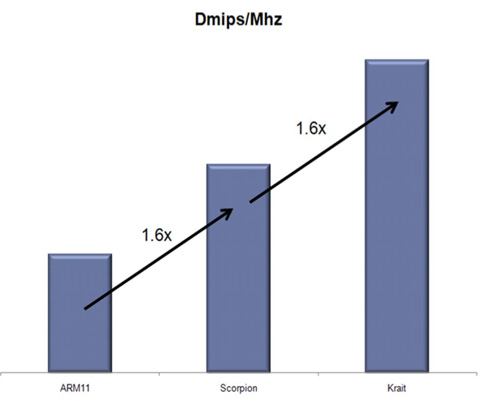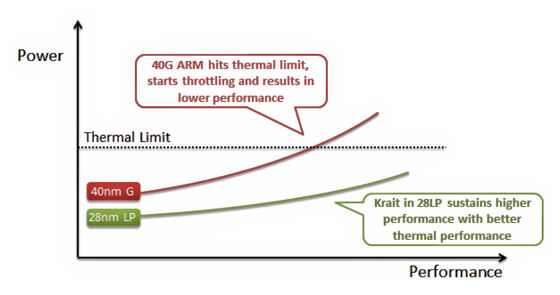
Qualcomm reveals its new processor Snapdragon S4 on its white paper. Here’s a block diagram of the chip from the Qualcomm White Paper:
It claims that this aSMP (asynchronous Symmetric Multi-Processor) approach delivers a 25 to 40% improvement in operating power for a given performance, as you can see in the following graph:Brian Klug & Anand Lal Shimpi compared the Snapdragon S4 with other chips:
| 2011/2012 SoC Comparison | |||||||
| SoC | Process Node | CPU | GPU | Memory Bus | Release | ||
| Apple A5 | 45nm | 2 x ARM Cortex A9 w/ MPE @ 1GHz | PowerVR SGX 543MP2 | 2 x 32-bit LPDDR2 | Now | ||
| NVIDIA Tegra 2 | 40nm | 2 x ARM Cortex A9 @ 1GHz | GeForce | 1 x 32-bit LPDDR2 | Now | ||
| NVIDIA Tegra 3/Kal-El | 40nm | 4 x ARM Cortex A9 w/ MPE @ ~1.3GHz | GeForce++ | 1 x 32-bit LPDDR2 | Q4 2011 | ||
| Samsung Exynos 4210 | 45nm | 2 x ARM Cortex A9 w/ MPE @ 1.2GHz | ARM Mali-400 MP4 | 2 x 32-bit LPDDR2 | Now | ||
| Samsung Exynos 4212 | 32nm | 2 x ARM Cortex A9 w/ MPE @ 1.5GHz | ARM Mali-400 MP4 | 2 x 32-bit LPDDR2 | 2012 | ||
| TI OMAP 4430 | 45nm | 2 x ARM Cortex A9 w/ MPE @ 1.2GHz | PowerVR SGX 540 | 2 x 32-bit LPDDR2 | Now | ||
| TI OMAP 4460 | 45nm | 2 x ARM Cortex A9 w/ MPE @ 1.5GHz | PowerVR SGX 540 | 2 x 32-bit LPDDR2 | Q4 11 - 1H 12 | ||
| TI OMAP 4470 | 45nm | 2 x ARM Cortex A9 w/ MPE @ 1.8GHz | PowerVR SGX 544 | 2 x 32-bit LPDDR2 | 1H 2012 | ||
| TI OMAP 5 | 28nm | 2 x ARM Cortex A15 @ 2GHz | PowerVR SGX 544MPx | 2 x 32-bit LPDDR2 | 2H 2012 | ||
| Qualcomm MSM8x60 | 45nm | 2 x Scorpion @ 1.5GHz | Adreno 220 | 2 x 32-bit LPDDR2* | Now | ||
| Qualcomm MSM8960 | 28nm | 2 x Krait @ 1.5GHz | Adreno 225 | 2 x 32-bit LPDDR2 | 1H 2012 | ||
They pointed out "Other than TI's OMAP 5 in the second half of 2012 and Qualcomm's Krait, no one else has announced plans to release a new microarchitecture in the near term. Furthermore, if we only look at the first half of next year, Qualcomm is the only company that's focused on significantly improving per-core performance through a new architecture. Everyone else is either scaling up in core count (NVIDIA) or clock speeds. As we've seen in the PC industry however, generational performance gaps are hard to overcome - even with more cores or frequency."
The performance is expected a big improvement over previous architectures.




No comments:
Post a Comment